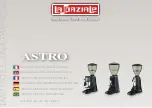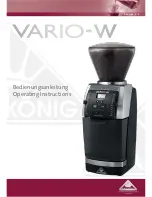
14
milk froth to 2 cm below the rim, wait for about 15 seconds and
then pour in the espresso; in that way, you will achieve the
classic three-layer formation.
Cleaning and care
∙
Before cleaning the espresso maker, ensure it is
disconnected from the power supply and has cooled down
completely.
∙
To avoid the risk of electric shock, do not clean the
appliance with water and do not immerse it in water.
∙
Do not use abrasives or harsh cleaning solutions.
∙
All removable parts may be cleaned with warm, soapy water.
∙
The sieve holder and
fi
lter sieves should be rinsed under
fresh tap water after each cycle of use, and also regularly in
hot soapy water.
∙
Empty the drip tray daily, and clean the drip tray and cup
stand with warm, soapy water.
∙
The exterior housing may be wiped with a dry or slightly
damp, lint-free cloth.
∙
The boiler outlet may be wiped with a moist cloth.
∙
The gasket area around the boiler outlet (at the bayonet
locking socket) should be cleaned using a brush. A hard
brush is recommended.
∙
Empty out any residual water from the container daily and
clean it in hot soapy water at regular intervals.
∙
Under the water container (which must be lifted out) there
is a cleaning tool with 2 wires (one thick, one thin). The
thick wire (STEAM) may be used in the case of a blocked
hot-water/steam nozzle; the thin wire (FILTER) is helpful to
unblock a
fi
lter sieve. For safe storage, always replace the
cleaning tool under the water container.
∙
The hot-water/steam nozzle should be cleaned immediately
after the frothing process. Wiping the nozzle with a wet cloth
should suf
fi
ce.
∙
If the hot-water/steam nozzle becomes blocked, proceed as
follows:
∙
Unscrew the hot-water/steam nozzle from the steam tube.
∙
Take out the cleaning tool from under the water container.
Push the thicker wire through the nozzle opening. Rinse
the nozzle under running water afterwards.
∙
Replace the nozzle.
∙
If the sieves are still blocked after cleaning them in hot
soapy water, proceed as follows:
∙
Take out the cleaning tool from under the water container.
Push the thinner wire through the opening in the base
of the
fi
lter sieve. Rinse the sieve under running water
afterwards.
Descaling
Depending on the water quality (its lime content) in your area
as well as frequency of use, the appliance should be regularly
descaled at 2 to 3 month intervals.
Any warranty claim will be null and void if the appliance
malfunctions because of insuf
fi
cient descaling.
Any commercially available
fi
lter sieve (porta
fi
lter) descaling
agent may be used.
Caution:
Do not pour descalers down
enamelled sinks.
∙
Prepare two litres of descaling solution according to the
manufacturer’s speci
fi
cations and pour it into the water
container.
∙
Replace the container in the unit.
∙
Fit the sieve holder with its sieve.
∙
Place a suf
fi
ciently large receptacle under the sieve holder
outlets.
∙
Connect the unit to the mains.
∙
Use the On/Off switch to turn the appliance on. The heating
process starts. Once the temperature indicator light shows
steady, turn the rotary control to position .
∙
The descaling solution now passes through the system into the
receptacle, which should be emptied in good time.
∙
Stop the process once the water container is about 2/3 empty.
∙
Empty the receptacle. Use the insulated ring grip to pull the
steam tube forward. Place the receptacle under the steam
tube.
∙
Turn the rotary control to the ‘Heating up’ position ( ).
∙
The hot-water indicator on the selector button (
) lights up.
∙
Turn the rotary control to the ‘Water/Steam’ position (
).
∙
Water is now emitted through the hot-water/steam nozzle.
∙
Let the water pass through the nozzle until the level in the
container has reached the ‘Min’ mark. Turn the rotary control
back to the neutral position ( ) and pour out any remaining
descaling solution left in the container.
∙
To clean the appliance after descaling,
fi
ll the container with
clean water and let it pass through the sieve holder (position
).
∙
Fill the container to 1/3 with clean water and let it pass
through the steam tube, until the level in the container has
reached the ‘Min’ mark.
∙
If lime deposits have built up on either of the other
fi
lter
sieves (ie those not
fi
tted at the moment), they should be
soaked in a solution of 200 ml water and 10 ml vinegar for
about an hour. Any remaining lime can then be brushed off,
before the sieve is thoroughly rinsed.
Problems and their possible causes
Filter sieve holder
The
fi
lter sieve holder drops down while brewing is in progress:
∙
The sieve holder is not
fi
tted properly: see
Inserting/
removing the
fi
lter sieve holder
or
∙
The boiler outlet is obstructed: clean it with a damp cloth
or
∙
The boiler outlet or its seal leaks: contact Customer Service
Coffee runs down the sides of the sieve holder:
∙
The sieve holder is not
fi
tted properly: see
Inserting/
removing the
fi
lter sieve holder
or
∙
The boiler outlet is obstructed: clean it with a moist cloth
or
∙
The boiler outlet or its seal leaks: contact Customer Service
Содержание KA 5990
Страница 3: ...3 1 2 8 7 6 4 5 3 12 11 10 9 16 18 19 17 14 13 15...
Страница 68: ...68 1 2 3 4 5 6 7 8 9 10 ESE 11 1 12 2 13 14 15 16 17 18 19 8 8 8 GR...
Страница 69: ...69 II 30 Max...
Страница 70: ...70 30 Max 1 000 ml On Off 20 35 ml 1 1 2 2 30...
Страница 71: ...71 ESE ESE ESE 30 30...
Страница 72: ...72 50 ml 60 C 68 C 6 8 g 20 ml 6 8 g 20 35 ml 6 8 g 100 125 ml 6 8 g 20 35 ml 6 8 g 20 35 ml 2 cm 15 2 STEAM...
Страница 73: ...73 FILTER 2 3 2 3 Min 1 3 Min 200 ml 10 ml...
Страница 74: ...74...
Страница 75: ...75 1 2 3 4 5 6 7 8 9 10 ESE 11 1 12 2 13 14 15 16 17 18 19 8 RU...
Страница 76: ...76 8 8 I II...
Страница 77: ...77 30 Max 30 Max 1000 20 35...
Страница 78: ...78 1 1 2 2 30 ESE ESE 30 30...
Страница 79: ...79 50 60 C 68 C 6 8 20 6 8 20 35 6 8 100 125 6 8 20 35 6 8 20 35...
Страница 80: ...80 2 15 2 STEAM FILTER 2 3 2 3 Min 1 3 Min 200 10...
Страница 81: ...81 Severin 2 a x...















































